Just like human medicine, early detection of canine disease improves the odds of a successful outcome. That’s why integrative veterinarian Dr. Julie Buzby is passionate about teaching you her five-minute weekly dog health and wellness scan. By committing to this at-home assessment, you’ll learn your dog’s baseline as well as basic skills that will help you monitor for changes. Should a problem arise, you’ll be poised to fast-track diagnosis with your veterinarian. Ultimately, these 10 touches could save your dog’s life.
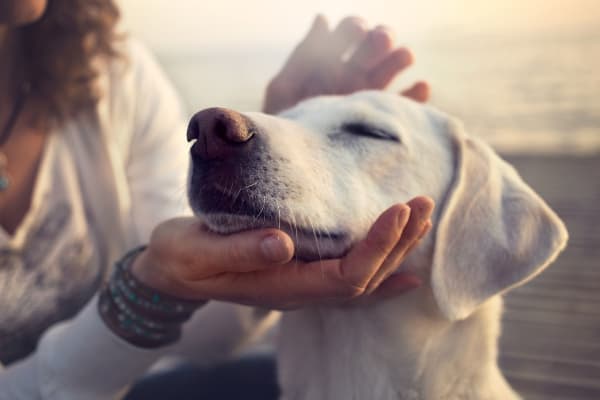
I absolutely love showering Jake, my sweet hound, with affection.
Sure, he enjoys having his belly rubbed, head stroked, and back scratched. But if I’m honest, I think it brings me more joy than it does him. I just love being close to my dog.
I know you can relate.

Keeping your dog healthy from tip to tail
Petting your furry friend is a “sport” you’ve already mastered. Good thing, too—because that’s the exact prerequisite you need for a new at-home healthcare habit I’m going to preview in this week’s blog. It’s called the Tip-to-Tail Health Scan™. Learning these ten specific touches will equip you to understand and monitor your dog’s health on a whole new level. Think of it as petting with a purpose!
My 5-Minute Tip-to-Tail Health Scan combines petting your dog with scanning his body in a methodical way to detect changes. Performing it weekly is recommended and all the more important as your dog ages.
While I’ve described each of the 10 touches below, you may prefer watching my video coaching sessions. My masterclass just launched! I invite you to sign up now. You’ll be one of the first to have access to my video library where I demonstrate my exact techniques for all 10 touches.
By learning these ten touches, you’ll develop confidence as your dog’s advocate, create a deeper bond of trust with your dog, and enjoy a closer partnership with your veterinarian.
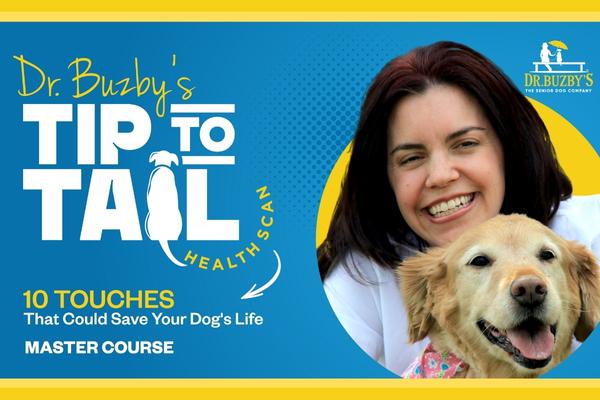
Practice makes perfect
A few years ago, our family visited the Money Museum in Kansas City. We learned that the Secret Service is the branch of government in charge of counterfeit money. Who knew? Surprisingly, the way agents train to identify fake money is not by scrutinizing counterfeit money. They train by looking at real money—over and over and over and over again so that when they see a counterfeit bill, it jumps out at them.
And that’s exactly what we’re going to do with our weekly wellness scan. You’re going to do it over and over and over while the weeks and the months and the years march on, so that when something changes, it will jump out at you. And those changes will be your red flags, alarm bells, and blaring sirens in your mission—early detection of your dog’s health concerns.
Before jumping into an overview of the 10 touches, I want to share a personal (and somewhat embarrassing) story with you that shows how important it is that you examine every part of your dog on a regular basis. As a new vet, I had to learn that the hard way.
Learning the hard way
The week after I graduated from veterinary school, I examined a patient during a routine vaccine visit. I was so new in my career that my physical exams were rather scrambled. I simply checked the dog over with no specific plan, pattern, or method.
I thought everything had gone well…until the next day. The client called, and she was irate—justifiably irate. She told the receptionist, “My dog has a rash all over her belly. I was just there yesterday and the vet didn’t even mention it.”
And it’s true, I had not.
During the exam, I never even looked at the dog’s belly. I examined the dog’s topside thoroughly but never looked under the dog. Of course, we brought the client back in and made it right, but I learned an embarrassing lesson.
From that day forward, I learned to perform physical examinations like a pilot going through a pre-flight checklist—slow, methodical, and with purpose. Twenty-three years later, it’s second nature.
As you begin your dog’s 5-minute Tip-to-Tail Health Scans, you’ll need to train yourself to do them in a very specific repeatable pattern week after week, or sadly, you’re bound to miss something just like I did.
10 touches that could save your dog’s life
For many of us, the best way to learn is by doing. I invite you to sit down with your dog and go through these 10 touches together in real time. The first three touches are going to cover the whole dog’s body…looking at the “forest” so to speak. The last seven touches cover very specific parts of the dog’s body where we will be admiring the individual “trees.”
I like to begin with a warmup exercise. This should feel to the dog like a quick full body rub. It should be a bonding time and very comfortable for you both. We want to set the tone for this to be a happy, positive experience.
So begin now by long strokes, petting your dog’s back and sides and down the legs. Work toward a mellow and thoughtful mood—not excited and playful. After a few minutes, you are going to change those strokes from random to intentional.
Touch 1: The body condition score
Body condition score is a big term, but it essentially means assessing your dog’s weight—but not just his weight in pounds. It’s your dog’s weight for his frame size.
It’s hard when a client asks, “What should my dog weigh?” They’re often looking for a precise number down to the decimal point. It’s much more accurate to look at things from the standpoint of a body condition score because it takes into account the dog’s weight in relation to his individual build and frame.
Weight has been statistically correlated in both human and veterinary medicine to health and life span. It’s something pet parents need to take very seriously. So let’s turn our hands and eyes to our dog’s “waistline” as you learn how to body condition score (BCS) your dog.
- Look for fat over the ribs— First, take the palms of your hands and stroke them down the rib cage on both sides, starting on either side of the spine and moving down to the belly. Second, move your hands to your dog’s shoulder/elbow area and slowly move your palms toward the tail. The goal is to easily feel the ribs without seeing them.
- Look from the side—Next, we’re going to do a quick visual inspection from the side. We want the abdomen to follow a bit of an upward curve toward the hind legs.
- Look from above— Finally, when viewed from above, you’re looking to see that your dog’s chest is wider than his abdomen. Your dog should not look like an oval or a rectangle when you stand over him and look down at his general shape. He or she should have a tapered “waist” just behind the rib cage, moving back to the hips.
More than 50% of dogs in the U.S. are overweight or obese, so you’re in good company if your dog falls into that majority, but you absolutely need to transform your dog into a leaner version of himself under your veterinarian’s supervision. For some weight management tips, check out these two articles:
- How to Help a Dog Lose Weight (Without Losing Your Mind)
- Is My Dog Overweight? Your 7 Most Weighty Questions Answered
Touch 2: The skin and coat
As we continue stroking the whole dog, we’re now going to turn our attention to assessing his skin and coat. More specifically, we’re looking for external parasites like fleas and ticks, which put your canine companion at serious risk of tick-borne disease in dogs. (If your dog’s lifestyle or environment puts him at risk for tick exposure, you should actually be doing this step daily, even if you are faithful with monthly flea and tick control.)
When petting your dog, you intuitively go with the lay of the fur. But in order to see down to the skin, you need to push the hair out of the way in sections and slowly move forward toward your dog’s head, examining the coat and skin from tail to head.
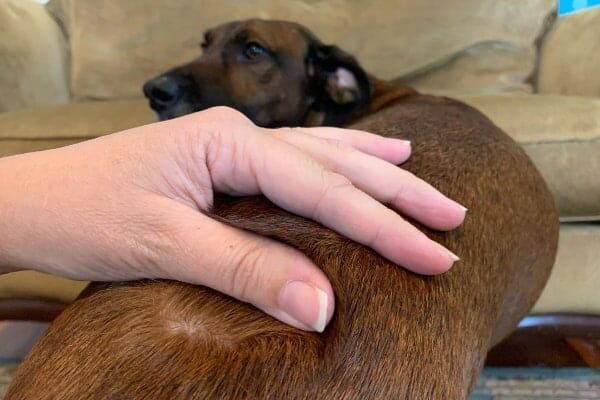
Why do you think I want you to start at the base of the tail? If you said “Fleas!” you are absolutely right. Fleas tend to congregate around the tail head, and it’s the first place a veterinarian will look when checking for the pesky parasites (and their droppings called flea dirt.)
Next, we’re going to lift up one leg at a time and view the skin on the corresponding underside of the dog. This is important because the skin is less furry here and more visible, but also because the abdomen, groin, and axilla (doggie armpits) are more affected by certain skin conditions. It’s so valuable for you to understand what your dog’s “normal” is here.
Touch 3: Lumps and lymph nodes
Let’s move on to touch number three, the two L’s—lumps and lymph nodes. You will now run your hands over your entire dog again, this time paying attention to the presence of any lumps or bumps.
Just like humans, lymph nodes are located in specific places in the dog’s body:
- The submandibular lymph nodes are under the dog’s jaw.
- The pre-scapular lymph nodes are in front of the shoulder blades.
- The axillary lymph nodes are in the armpits.
- The inguinal lymph nodes are deep in the groin and hard to feel even when enlarged.
- The popliteal lymph nodes are on the back of the hind legs, behind the dog’s knees.
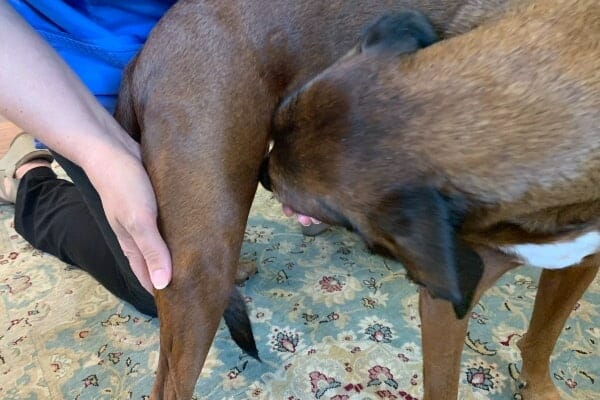
Normal here is not feeling anything when you check these spots. Lymph nodes are pea-sized to maybe grape-sized in a very big dog, so if all is well you shouldn’t feel anything at all.
If you find a lump on your dog, whether you believe it to be an enlarged lymph node or a tumor, make an appointment with your veterinarian. I love the mantra of Dr. Sue Ettinger, a board-certified veterinary oncologist, who says that if a lump is pea-sized or greater and has been there for at least a month, it needs to be aspirated. Once again, knowing your dog’s baseline is a critical to quickly noticing when a lump has popped up.
Even board-certified veterinary oncologists—the best of the best—cannot determine the nature of a mass simply by looking at it. You need to evaluate extracted cells under a microscope to get answers. Fine needle aspiration accomplishes this.
To learn more about how veterinarians diagnose lumps and bumps and to see a short video of a fine needle aspiration, check out my article on lipoma in dogs.
Touch 4: The ears
The next three touches are all on your dog’s head.
Touch four is the ears, and in all fairness, the ears probably aren’t one of the touches that will save your dog’s life. However, ear disease is really painful, so it’s critical you’re proactive about monitoring them.
Veterinarians use all of their senses when trying to make a diagnosis, and I need you to do the same. Try not to be grossed out. You’re going to have to take one for the team as you look—and sniff—your dog’s ears. Discharge and odor are both red flags. An offensive smell generally indicates an ear infection (i.e. otitis in dogs) because the odor is produced by yeast or bacteria.
First, you’re going to gently flip back the pinna—the flap of the ear—and look for any sort of discharge or debris. Certainly, there is diagnostic value in taking debris from an ear, smearing it on a microscope slide, and looking at it on a cellular level to determine the offending pathogen and the best treatment plan.
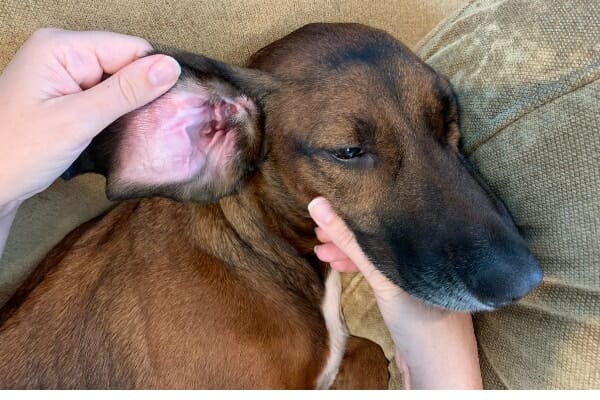
But I’m not asking you to diagnose anything. I’m just asking you to notice, “Hey, my dog’s ear is pinker than normal. It has gunk in it. There’s a funky smell,” and understand that it warrants a veterinary visit. As I said, ear problems are painful for pets and a prime example of early detection equaling faster treatment times, simpler treatment protocols, and better outcomes.
Touch 5: The eyes
For touch five, you’re going to look in your dog’s eyes. Because you’re initiating a staredown, use caution even with your own dog. Go slow and be reassuring. Expect your dog to frequently avert his eyes out of respect.
Use your index finger and thumb to gently open the eyelids. You’ll need to do this inspection quickly because most dogs won’t hold this pose long. Look at the lids, the whites of the eyes, and peer into the pupil itself.
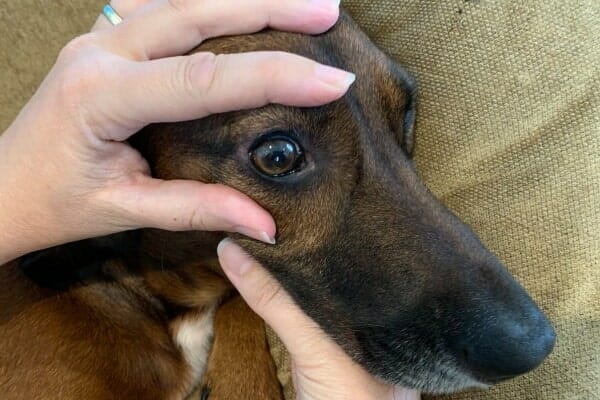
You’re scanning for anything abnormal—swelling, redness, color changes, or growths. Get into the habit of also noticing your dog’s normal pupil size since changes in pupil size and position can indicate problems ranging from pain to brain disease. In senior dogs, rapid eye movement can also be a classic indicator of a condition called old dog vestibular disease.
If you’re not sure if something looks normal, check the other eye to identify the corresponding structure. If you find something in one eye that doesn’t exist in the other, call your veterinarian. Eye problems like glaucoma in dogs are very painful and can turn into emergencies fast. They aren’t something to mess around with.
Senior dogs may also have nuclear sclerosis in dogs (a normal age related change to the lens) and cataracts in dogs (an abnormal opacity of the lens). These two conditions—one serious and one not—can look similar to many dog parents. So it is important you consult your vet anytime you notice eye changes.
Touch 6: The mouth, lips, gums, and tongue
Touch number six is the mouth, lips, gums, and tongue. This touch is all about observing color.
You don’t want to learn how to do this during a health crisis because you won’t be able to do it accurately. The weekly scan is the perfect time to learn where to check your dog’s gum color and your dog’s normal shade of pink.
Pretty in pink
I could have written a book called 50 Shades of Grey, and it wouldn’t have been R rated. It would have been about knowing your dog’s normal mucous membrane color because gray is a shade we never want to see. Some dogs have pigmented, black gums, but even then, you should be able to find a section of non-pigmented tissue to assess for pink mucous membranes.
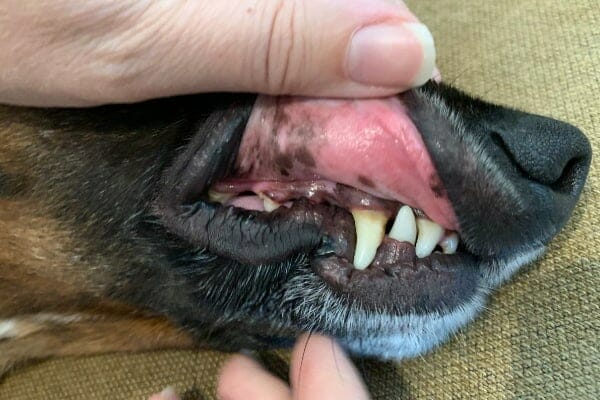
Note the black pigment here, normal for this dog.
Looking at the color of the tongue is also important. Just like the gums, we’re looking for a healthy pink rosy color. Any shade of blue, gray, purple, or white is likely a critical veterinary emergency.
As a measure of hydration, you can also rub your index finger across your dog’s gums while holding up their lip. Your finger should glide over the gums because there should be enough moistness on the membranes to act as a “lubricant.” If instead, you find the gums to be dry or tacky, often this indicates dehydration or a more serious health issue.
As with all these touches, if you have more than one dog in your house, you can look at their gums and compare, to better help you understand what normal looks like.
Check those pearly whites
You will also be assessing the teeth in this step to make sure they’re not cracked or fractured. Use right-to-left symmetry to help you understand your dog’s normal. If you’re concerned that the crown of a tooth looks weird, check the same tooth on the other side for comparison. It’s not uncommon for dogs to fracture teeth. So if you note any abnormality, please follow up with your veterinarian.
Lastly, open your dog’s mouth completely and take a quick peek “down the hatch.” The mouth is a very common place for dogs to get cancer, so you should be checking for any masses in the throat, mouth, or lips to the best of your ability.
To learn more about dental disease in dogs, check out my article: Dental Disease in Dogs: Why Prevention is the Best Medicine.
Touch 7: The legs, paws, and nails
Your dog is probably going to relax a little as you move away from his head and on to the rest of the body. So this is a good place to give a treat, offer some praise, and breathe.
You are now going to scan your dog’s legs, paws, and nails. And it’s great that we have four legs on a dog because that allows for a symmetrical standard to measure against if you ever wonder if something is abnormal. We’ve talked about the gift of symmetry throughout all these touches, but it’s especially helpful for the legs.
Please cup your hands around your dog’s front legs, as close to the body as possible, and then slide down both forelimbs at the same time toward the paws.
Next you will do the same thing on the rear legs, simultaneously assessing both hind limbs—checking for symmetry, feeling for any enlargement, swelling, or tenderness.
Clients often look at me like I’m clairvoyant as I’m palpating their dog’s legs and say something like, “So does your dog limp on his right hind leg?” Their eyes get wide and they say, “How’d you know that?”
Well, it’s simply the art of observation in touch—comparing right to left symmetry and noting that a joint is enlarged and inflamed on one side. Those observations typically correlate with pain, and a dog will favor a painful leg.
Next, take each paw, look at the top side, and then flip it over to look at the pads. Gently spread the dog’s paw so you can look between the toes. This is a common place for sores, especially secondary to allergies, which can be missed.
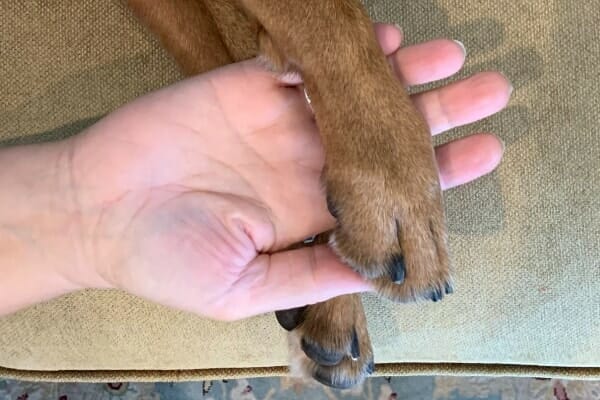
Dog toenails are a soapbox of mine that I could discuss forever. Suffice it to say that your dog’s nails should be trimmed to an appropriate length and maintained on a regular basis. This is important to your dog’s posture and gait. It is also a good way to avoid a situation where your dog ripped a nail off.
If this is not something you already do yourself, I would love to teach you with my new ebook, How To Trim Your Dog’s Nails Without Blood, Sweat, or Tears. If at-home dog nail trims are not a possibility, please have your veterinarian or groomer keep up with your dog’s toenails regularly.

Touch 8: The chest
Next, we move to the chest, heart, and lungs. I use a stethoscope at the veterinary hospital to listen to both, but I want you to feel empowered to do these touches anytime, anywhere, without special tools.
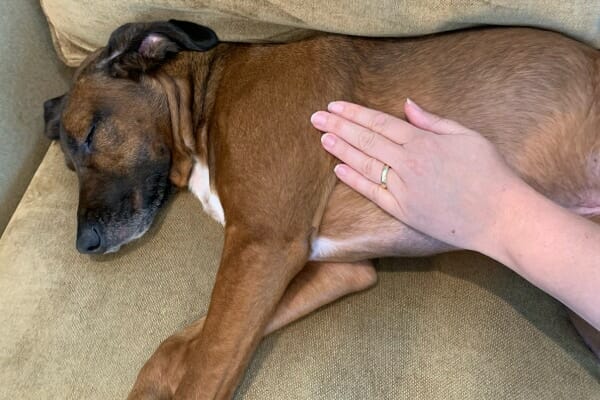
Here is the stethoscope-free method for observing your dog’s heart rate. Place flat fingers on the left side of your dog’s chest just behind his leg. Do you feel your dog’s heart beating? Pay attention to the rate and rhythm. (Avoid checking your dog’s heart rate right after exercise as it will be higher than normal. Your objective is to track your dog’s resting baseline rate.)
Observe your dog’s respiratory quality and rate. Consciously note what is normal for your dog so you’ll quickly recognize abnormal.
Want to know average “norms” for your dog’s vital signs? Check out my article: Keeping a Pulse on Your Dog’s Vital Signs.
Touch 9: The abdomen
Touch number nine is the abdomen or belly. As veterinarians, we palpate deeply and specifically. It honestly took me about two years in vet school to acquire this skill. Prior to that, everything just felt like oatmeal. Fear not. I am not asking you to identify your dog’s liver margins or intestinal loops. I just want you to know the general shape of your dog’s belly. That way, if your dog ever has an emergency like bloat, you’ll quickly spot the problem.
Also, consider your dog’s abdomen from a softness/hardness standpoint. A dog that has belly pain from pancreatitis, for example, tends to guard their belly because it’s painful. In that situation, the abdomen feels tense and hard to the touch. But that’s not a normal baseline for a dog who is calm and handled gently. Your healthy dog’s abdomen should feel soft.
Touch 10: The rump
Our grand finale is checking your dog’s hind end and under the tail. I can’t tell you the things I’ve noticed below dogs’ tails just by going where no man has gone before. My sweet conscientious clients often gasp, “I had no idea!”
So we’re going to look around the anus for swellings, growths, skin issues, anything protruding, and parasites like tapeworms. A few notes:
- Fecal material can get caught in the fur around the anus and lead to skin infection/irritation, and in some cases, difficulty pooping. Make sure the area is always clear and clean.
- For female dogs, it’s important to look at (and around) the vulva. Check for discharge, skin discoloration, and odor. My belief is that there are a lot of female dogs running around with undetected urinary tract infections as a result of vulva hygiene issues.
- Tapeworms in dogs resemble little pieces of dried rice. They can be found around the anus or matted to the fur of the tail.
Looking under your dog’s tail for discharge, odor, and growths may not be your first choice way to spend time with your dog, but it’s a very important step.
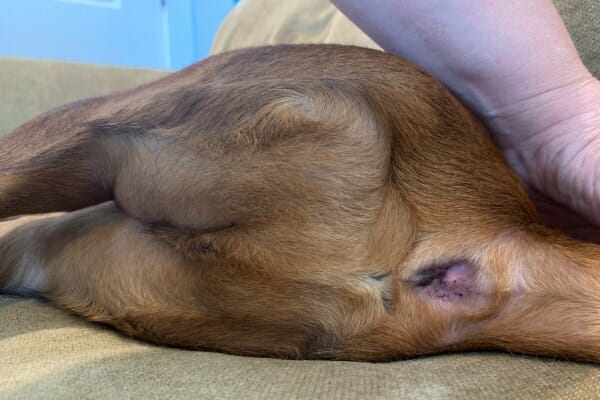
You don’t have to be a pro—just proactive
How long did it take you to walk through this wellness scan? Ten minutes? Twenty? I’m confident the more you practice it, the more efficient you will become. By the time you’ve earned your black belt in the Tip-to-Tail Wellness Scan, this whole process should only take moments.
Remember, if you’d like to fast-track the learning curve, you can get instant access to my comprehensive video master course, Dr. Buzby’s Tip-to-Tail Health Scan. Through the course, you’ll get access to 13 video tutorials where I demonstrate all 10 touches. Plus, you can save 50% on the regular course price with code TIPTOTAIL. (Not valid with other offers)

Remember, I’m not asking you to change your daily routine. I’m not saying, “All right, I need you to go to the gym for 90 minutes a day so figure out how to work that into your schedule.” I’m just asking you to pet your dog with a little more intentionality. You don’t have to be a pro—just proactive.
Sound too good to be true? Well, there may be a downside. The risk is that I send you running to your veterinarian, panicked about a bunch of normal stuff. So if you go rushing to your veterinarian for a bump on your male dog’s belly that turns out to just be a nipple, please don’t send me the bill. Wink.
You, your vet, and your dog make a great team
In all seriousness, this at-home scan requires working closely with your veterinarian. But consider the fact that your vet may examine your healthy dog only a few times a year while you’re touching and petting your dog a zillion times a day. You are the logical first line of defense.
Will practicing these 10 touches make you a better pet parent? “Yes!” is an understatement. They will make you a better advocate, a better care provider, and a better veterinary client.
Start today folding a 5-minute weekly health scan into your routine. Your dog will soon look forward to it, and you’ll have the reassurance that your dog is the healthiest he can possibly be!
Has a “touch” helped you discover a health concern with your dog?
Share your story in the comments below. We’d love to hear your story!


I wish that I had found your advice with my first dogs. After they all passed, I adopted two puppy mill rescues who it appears were tortured for the first 9 years of their lives. Trying to give them a good life has been both the hardest thing I have ever done and the most awarding. How I wish that I could give them a body scan but I struggle to even brush one of their tails and the second dog is just beginning to let me give him a little petting on his chest and hips. The reason for my comment today is because I took the pup in today who is very affectionate for an ultrasound. He came home very despondent. I hope that he rebounds like he usually does after stressful events but the vet tech said that he was given a sedation that would make him completely aware of what was happening but be unable to move. This sounds to me like torture. They kept him all day for something that my dog in the past was able to get in a short visit and if memory serves also my cats. I was told that the vet today preferred sedation for her ultrasounds and I am wondering if that was for her benefit and was rather a form of malpractice. Please let me know your thoughts.
Hi Nicole,
I am sorry your rescue pups have been through so much and am glad they are now safe in a loving home with you. Without knowing all the details of what was done at the clinic, it is hard for me to offer specific conclusions. I can say that it is standard practice to sedate animals for ultrasound exams. Most dogs and cats are not willing to lie still and not move while being positioned correctly for the views that are necessary when doing a complete scan. Occasionally we may be able to get away with no sedation if just trying to get a quick peak at something simple (like the bladder), but again this is not common. Sedation is not full anesthesia, so yes, the animals are awake but calm and non-reactive. I think the tech used the wrong wording to try and describe the effects of the sedation. The most commonly used sedation and anesthesia medications also cause amnesia, so the animal doesn’t have any “negative memories” about their visit. I beg you to try and stay away from using the word “malpractice”. This has so many possible negative ramifications and the veterinary community as a whole is already struggling with a very high suicide rate. If you have lingering concerns or questions about your dog’s recent vet visit, I encourage you to reach out to your vet and have an honest conversation. Lack of communication from both sides can lead to hurt feelings and strong emotions. Hoping I was able to offer some insight and wishing you and your sweet boy all the best. ♥
Thank you for allowing me to post this publicly on my Facebook page. Who knows how many dog-lovers will see it and learn? who otherwise might miss clues to a beloved pet’s impending health problems. So generous of you — thanks.
Hi Patricia,
Thank you for helping to get the word out about how important it is to monitor your dog’s health at home on a regular basis. Best wishes and keep up the good work!
Good Morning Dr. Buzby, thank you for your article. I had a Shitzu, she lived for 19 wonderful years. she was misdiagnosed for a collapsed Trachea, it was actually allergies. I have to tell you, I didn’t think I could live without my little girl Sadie, but I survived. But, to this day I still miss her. Before Sadie passed away, a stray dog came up, I did everything to run her off. I hate to tell this, but, I even threw rocks at her. But she kept coming back. That was about 14 years ago. Today, my precious little “Hap”, is truly “my heart”, I love her, and she loves me. She is beginning to have issues, but I am doing my very best to keep her happy, and feeling good, because she does so much for me. My long point being, when your sweet fur babies go over the “Rainbow Bridge”, put your grief and love ❤️ into another little fella, you have so much love to give, but more importantly, pets are so important for us, or me anyway. My little Hap, does so much more for me. She makes my day and my life so much better, and I try to do as much for her. Thanks again, Dr. Buzby
Hi Barbara,
I am glad you enjoyed the article. I appreciate the positive feedback! Thank you for sharing your experience with our readers. I hope Sadie’s memory will be a blessing that stays with you always and give your sweet little Hap a hug for me!
Hi – I am grateful to have stumbled across your article. It was written so clearly and so lovingly. How generous of you to encourage and empower us by sharing your expertise. I am in awe of your ability to take complex concepts and distill them into a practical application for lay people.
I am a health care professional for people which translates into no expertise with dogs! However, as I read your article I kept thinking “Of course! Of course I ought to deliberately learn the baseline/normal presentation of my dogs!”.
While I may not have a comment with a story about how this article helped me find something today, I am certain that this article will prevent pain and illness and save the lives of 100’s of dogs. In so doing it will save the hearts of their humans and help decrease our mental health crisis. That is not hyperbole, you have done a great service.
Hi Marion,
You have definitely made my day! Thank you for taking the time to leave your feedback and I greatly appreciate the kind words about the article. I am glad you found it helpful and hope it will help you take charge of your dog’s medical care. Thank you for your work in the human health care field….I couldn’t do people! Haha. Best wishes to you and yours. ♥
Wonderful article ! Thank u ! I have always followed u r recommendations !
I have a 5 yr old shitzu and the loved of my life ! He spits up yellow mucus ! And gages and sound light a fog horn coughing !
Had had about 2 episodes for 3 days now !
Vet thinks it is allergies I pray to god !
I am a retired medical x ray ultrasound mri tech and am so nervous when he gags I think it is his last breath !
I have read this article 2 times tonight to help me relax and sleep !
Wonderful info thank u thanks !!!
Hi Shelbywells,
Thank you for the kind words and positive feedback about the article. I hope you can get some answers about your little pup’s gagging and coughing. Best wishes for a speedy recovery!
This was a great article, well written, easy step by step guide for people to be able to take part in their dog’s care and not be just observers, PLUS it helps their dogs get used to the handling they will get at their vet visits.
I wish I could print this out for all our clients.
Thank you for sharing your wisdom. 🙂
Hi Heidi,
Thank you for the positive feedback on the article! I am glad you found it to be insightful and hope it will help you or others in the future. ♥
I’m starting right now. Thank you so much. Vet prices are outreagous.
Hi Lisa,
It is true that prices are on the rise. Unfortunately, costs associated with veterinary medicine are affected by rising prices for goods and services just like other businesses. Luckily, veterinary prices are still leaps and bounds cheaper than human medicine. If you are worried about having the money to address possible future medical needs for your dog, I highly recommend you look into pet insurance. I am glad you enjoyed the article. Best wishes!
Does vestibule in old dogs start quickly like after a walk, now should tell you that she is 1 pound and a half so she is very tiny and 10 hrs old. My question is a symptom to have cold paws as if she went out in rain, but no rain. The symptoms started late yesterday 11/9 all other symptoms she seems to have. I love her so much but I have done all her care and now senior myself and am very sad as I can not afford vet charges☹️?
Hi Colleen,
I am sorry your sweet girl is having some issues. I understand your concern about wanting to do what is best for her but needing to stay within your budget. Since I have not examined your dog myself, I really can’t make specific recommendations. Do you have a local veterinarian that you use for vaccines and wellness visits? I strongly recommend you call a vet and get your girl checked out. You can ask for pricing details while scheduling your visit to make sure it’s something you can handle. You can also reach out to your local humane society and rescue organizations as these may have info on financial assistance. I hope you find the answers you are looking for. Best wishes.
I would like to make a copy of this is it possible?
Hi Linda,
You should be able to print the article page from your internet browser. If that doesn’t work, you can highlight all the text you want to copy with your mouse, then right click to print or copy and paste into a word document. After you save the text into a word document you can print it. I hope this helps!
While doing TTouch with one of my dogs I discovered a small mass (about the size of an eraser) right outside his rectum and a small mass on his nose that looked like a blister / water drop that were not there before. I took him to the vet, they aspirated them and said, “they need to come off!” We scheduled surgery and prior to removing the one by his rectum they emptied his anal glands and that is when they discovered the mass. He was showing no adverse signs. The vet removed the mass and we had a year and 2 days with him before the cancer returned. Time I would not have known was so precious without the early diagnosis. The vet told me that every dog over the age of 7 years should have a rectal exam as part of their annual exam but it often gets missed because dogs don’t like it and if they aren’t showing signs of a problem it’s easy to skip. So, I now tell EVERYONE to ASK for it for their dog and encourage them to do body scans. This article is well written and easy to follow and I will be sharing it far and wide. Thank you for writing it all down in an easy to follow format.
Dear Jennifer,
Sorry to hear to hear of what you and your dog have gone through, but kudos to you for the way you’ve navigated the situation! Thank you for sharing our blog; it is my passion to write for you and all proactive pet parents. Thanks again for your comment and support! ❤️
Agreed Jennifer! I am a vet tech and I have been training Drs. At my hospital who have recently graduated. I tell them the same thing, however I also add, instead of using a fecal loop to get a stool sample, which of course is easier, they should really do a rectal check to ensure they palpate normally but also to check the anal glands to make sure they aren’t full. Overly full anal glands can be very uncomfortable and, in some dogs, could even rupture.
Great article…well written and very informative
Thanks so much for your kind words, Tracy!
Very informative. How to examine your dog thru touch is so beneficial.
Thanks so much, Pepi, for your kind words. Please share the article with your dog-loving friends, too! 🙂
Fantastic information, thanks!